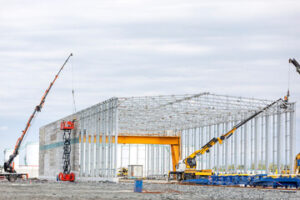Drywall Repair Phoenix is an essential skill for homeowners. Minor blemishes like nail holes and dents can be covered up with quick and easy patching.

A quality job requires careful attention to detail to ensure a seamless, visually appealing finish. This article will cover techniques for repairing medium to large holes in drywall, as well as damaged corner beads.
Small holes caused by nails or screws, drywall screws, or minor dents and dings from moving furniture or kids or pets playing indoors are easily handled with a bit of drywall compound and a putty knife. For medium to large blemishes, you’ll need to use more extensive patching methods.
Before attempting a drywall repair, clean the damage and remove any loose debris from the area. Drywall patching products are available pre-cut for a wide range of hole sizes. These can be used to fill holes from 6″ to 36″.
A drywall patch kit is a quick and easy option for repairing holes up to 16″. Simply adhere the patch to the wall, centering it over the hole. If you are working on a larger hole, you may want to install furring strips (thin pieces of wood) behind the patch for support.
To begin, apply a strip of drywall tape to the seam where the hole is located, making sure the ends of the tape overlap the edges of the existing tape. Once the tape is in place, apply a thin coat of joint compound over the entire seam and let it dry. This will help to prevent future cracking.
Once the seam is filled and smoothed, add a second coat of joint compound. Allow it to dry completely before sanding. When sanding, always feather the edges outward so that the new surface blends seamlessly with the rest of the wall.
When the drywall is completely smooth, it’s ready for priming. Primer helps the drywall accept paint better and eliminates any imperfections that could show through the final coat of finish.
When tackling any type of drywall repair project, be sure to work with a professional who has the skills and experience to assess and complete repairs correctly. The right approach to the problem will ensure a quality result that can be enjoyed for years to come. For professional assessment and drywall repair services, contact the team at Sierra View. We provide prompt, efficient service and high-quality results. Our specialized team is highly-trained and experienced with the latest techniques and equipment.
Patching Small Holes
Drywall is incredibly easy to hang, drill into and paint, but it can be damaged fairly easily. Small dents or holes can happen when you’re moving furniture or hanging art, and kids and pets can leave their mark as well. Usually, these are just unsightly and can be fixed with some spackle or joint compound and a putty knife.
First, clean out the hole and make sure it is as flat as possible. Then, use a drywall patch kit to get a ready-to-use patch. This is the easiest option for most homeowners, since it’s usually self-adhesive and has everything you need.
If you’re not using a patch kit, cut a piece of new drywall that is an inch or two larger than the hole, and lay it over the hole. Then, sand the edges to make them smooth, and knife some spackling over it thick enough to penetrate the mesh. Be careful not to get too much spackling on the edges, or you’ll have to feather it out into the rest of the wall.
Once the spackling is on, cut some strips of wood furring and screw them to the back of the drywall. This will help reinforce the drywall and keep it from collapsing into the hole. Then, apply the drywall patch as you would for a medium to large hole, and finish it off with a coat of joint compound.
When it comes to repairing drywall, there are three types of damage: cracks, holes and stains or soft spots. Cracks often occur along a seam or at a corner, and can be caused by shifting or changes in temperature.
Holes in drywall are generally caused by nailing or drilling, but can also be from plumbing or electrical work. Lastly, stains or soft spots are caused by water damage, and can be a sign of mold or mildew.
Depending on the severity of the damage, you may need to call a professional. However, with a little bit of time and some patience, most homeowners can fix drywall damage themselves. Just be sure to wear a respirator while cutting or sanding, as it can create dust that will enter your lungs.
Filling Large Holes
Drywall is designed to be a durable wall surface, but it can get damaged over time. The damage may manifest as cracks, holes of varying sizes, or even mold. It’s important to understand what the repair process entails and when to DIY or hire a professional.
Spackle repairs are the least invasive and easiest type of drywall repair. This type of repair can cover small dents and dings that may result from moving furniture, from nail or screw holes, or from kids or pets playing indoors. These types of blemishes can be fixed quickly with spackle and a putty knife. However, they do need to be allowed to fully dry if you want to paint over them.
For larger dents or holes, you can use a patch kit that is available at most hardware stores. These kits come with a self-adhesive mesh patch that sticks to the drywall and covers the hole. These are fast and easy to apply, but it’s important to ensure the patch is flat and properly adhered.
It is also important to assess the integrity of the drywall in any area that needs repair. Doing so can help to prevent further damage and ensure that the resulting repair will be long-lasting. For example, if you notice that the drywall in a particular area seems soft or spongy, this can be an indicator of water damage and it is important to have it repaired as soon as possible.
A professional drywall contractor will have the experience and skills to accurately assess the extent of any damage and ensure that it is repaired correctly. They will also be able to complete the repairs in an efficient manner, minimizing disruption to your daily life and ensuring quality results.
If you decide to take on the repair yourself, it’s important to research the project carefully and to purchase all the necessary materials. Be sure to consider all the costs associated with the repair, including local material / equipment delivery and service provider transportation to and from the worksite. You should also account for labor setup and mobilization costs, as well as any permits or inspection fees required for the project.
Primer and Paint
When it’s time to paint, touch up or repaint, it’s important to prime the area first. Priming creates a solid foundation for the new coat of paint and helps to keep it from peeling later on. For best results, look for a primer that matches the existing color of the wall and has a similar sheen. It also makes it easier to change the color of the paint if necessary.
Shop a wide variety of painting products, including paint, primer, brushes, rollers, and buckets. You’ll also find specialty products like popcorn ceiling spray texture and drywall repair compounds. A sanding sponge, utility knife and putty knife will help you achieve the smooth finish that’s key for a professional-looking repair.
A drywall repair product that includes joint compound and sanding tape offers the convenience of one-step preparation for painting. It works quickly to repair nail holes and cracks in drywall. It also provides a strong base for additional repairs to drywall and plaster walls. This type of drywall repair kit comes in handy for small jobs, such as fixing holes in closets and cabinets, or to improve poorly cut openings around plumbing and gas lines.
If you’re tackling a bigger project, a drywall repair product that includes primer and sanding tape provides a more comprehensive solution. It’s designed to save time and effort, while still delivering a quality finished result.
Choose a water-based or oil-based primer for your project, depending on the needs of your surface. Water-based primers are quick drying and easy to clean up. They’re a great option for most interior and exterior projects, especially if you’re using a light color or a low VOC (volatile organic compounds) paint. Oil-based primers provide thick coverage that’s ideal for many types of painting jobs, but they’re slower drying and release VOCs.
Whether you’re covering an old bright shade with a muted neutral or changing the entire wall color, you can get a flawless finish with a little planning and the right drywall repair products. For more extensive damage, consider hiring a professional to assess and repair the wall. A skilled technician will ensure the repaired area blends seamlessly with the rest of the wall, reducing the risk of re-damage or other issues.




